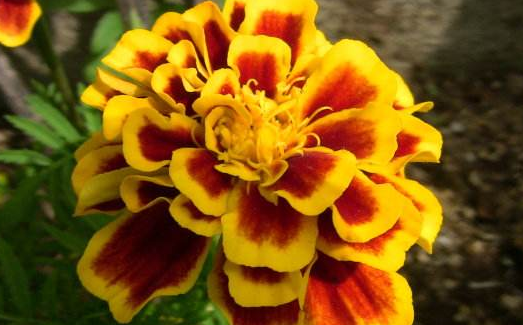How to raise the tiger flowers?
Soil
The cultivation substrate of Huyan Flower is the slightly acidic soil with loose fertility, rich organic matter, good air permeability, strong ability of water and fertilizer conservation but no stagnant water. generally, rotten leaf soil, peat soil and coarse sand were prepared at 2:1:1 and mature cow manure or chicken manure was used as base fertilizer.

Temperature
Hu Yan Hua likes to grow in a high temperature, humid and semi-shady environment, it has a strong cold tolerance, and it can not be placed in direct sunlight, otherwise it may damage the plant, the plant's favorite growth temperature is between 17 and 30 ℃, in winter, the temperature is too low, it is generally necessary to keep the plant warm, and the plant can survive the winter safely if the temperature is maintained above 5 ℃.
Light
Tiger Yanhua likes the sun very much, but it is afraid of direct sunlight, so when the summer sun is strong, it is necessary to shade the plant with 50% / 70% sunshade, which is very beneficial to the growth of the plant, otherwise the leaves of the plant may be burned, become dry and yellowing, and pay attention to keeping the plant warm in winter so that it can survive the winter smoothly.
Watering
Tiger Yanhua has strict requirements for watering methods, because the plant itself is not resistant to drought, so it is necessary to maintain a high humidity around the plant during its growth, but be careful not to irrigate too much water in order to avoid stagnant water in the pot. this leads to plant root rot, so it is generally fine to water it once a day.
The above is about how to raise the tiger flowers. Let's take a look at what else we need to pay attention to.
How to raise the tiger flowers?
How to raise Tiger Yanhua the cultivation substrate of Tiger Yanhua is slightly acidic soil with loose fertility, rich organic matter, good air permeability, strong water and fertilizer conservation capacity but no stagnant water. generally, rotten leaf soil, peat soil and coarse sand are prepared at the proportion of 2:1:1 and mature cow manure or chicken manure is used as base fertilizer. Temperature and light Huyan flowers like high temperature, humid semi-shady environment, strong cold resistance, avoid direct sunlight. The growth temperature is 17-30 ℃, can survive the winter safely above 5 ℃, and can withstand 0 ℃ low temperature for a short time. Special attention should be paid to shading in summer cultivation and management, and the shading rate should reach 50%, 70%, otherwise the leaves are prone to yellowing. It should be cultivated in greenhouse in winter, or other heat preservation measures should be taken. Watering and fertilizing Huyan flower has relatively high requirements for water, is not resistant to drought, the growing season to maintain a high air humidity, but to avoid stagnant water, otherwise it will cause rotting roots. It is usually watered once a day. Foliar compound fertilizer is applied once a week during the growing period, and it is appropriate to apply it thinly and more. More application of nitrogen fertilizer is beneficial to the green leaves, but the leaves are fragile. Do not spray water directly on the leaves when fertilizing, otherwise it is easy to cause leaf rot in the case of high temperature and lack of ventilation. In addition, it should be noted that the fertilizer demand of Huyanhua has a great relationship with the temperature. Generally speaking, more topdressing can be applied when the ambient temperature is higher, while less topdressing can be applied if the ambient temperature is lower. Reproduction method
Tiger Flower can be propagated by sowing, plant division, cutting and tissue culture.
Matters needing attention in domestic raising of Tiger Flower Common Diseases of Tiger Flower
In the growing season, especially when it is hot and rainy in summer, it is very easy to develop root rot and stem rot.
Common insect pests in tiger flowers
The main pests of tiger Yan flower are leaf beetle, nocturnal moth, lamp moth, snail, slug and so on, which easily engulf the leaves into holes.
Points for attention of Tiger Flower Common Diseases of Flower
In the growing season, especially when it is hot and rainy in summer, it is very easy to develop root rot and stem rot.
Common insect pests in tiger flowers
The main pests of tiger Yan flower are leaf beetle, nocturnal moth, lamp moth, snail, slug and so on, which easily engulf the leaves into holes.
That's all for today. I hope you have mastered the above knowledge and know how to raise tiger flowers, so I wish you all a beautiful and healthy tiger flowers.
- Prev

Countermeasures for yellowing of grape leaves
Iron deficiency yellowing can be prevented by whole plant spraying 0.1% ferrous sulfate, 0.2% urea and 3 taels of aged vinegar (each sprayer). The whole plant was sprayed with 0.2% urea and 25000 times of green protective solution, and the fruiting branches and half leaves were coring at the same time.
- Next

How to sow malachite grass
First, the sowing time of malachite does not have a clear stipulation on the time at which it must be sown. It can be carried out in all seasons of the year. For example, there are manufacturers in the south that specialize in selling malachite, and they sow a large number of seeds. Generally, they will choose to sow seeds from July to August, so that they can wait until National Day.
Related
- Fuxing push coffee new agricultural production and marketing class: lack of small-scale processing plants
- Jujube rice field leisure farm deep ploughing Yilan for five years to create a space for organic food and play
- Nongyu Farm-A trial of organic papaya for brave women with advanced technology
- Four points for attention in the prevention and control of diseases and insect pests of edible fungi
- How to add nutrient solution to Edible Fungi
- Is there any good way to control edible fungus mites?
- Open Inoculation Technology of Edible Fungi
- Is there any clever way to use fertilizer for edible fungus in winter?
- What agents are used to kill the pathogens of edible fungi in the mushroom shed?
- Rapid drying of Edible Fungi

